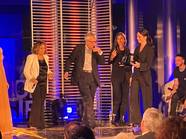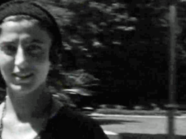Remember to never forget. On February 4th, the Italian Cultural Institute together with the Centro Primo Levi of New York will celebrate “Il Giorno Della Memoria” (Remembrance Day) will present The Liberty of knowledge: Remembering Rita Levi Montalcini. The event is entirely dedicated to one of Italy’s greatest Jewish scientists, the Nobel Prize winner Rita Levi Montalcini, who died last December at the age of 103.
Levi Montalcini was an Italian neurologist born into a traditional Jewish family. During the fascist regime and especially after the promilgation of the racial laws in 1938, she was not allowed to work. However, because of her tenacity, determination and passion for science she continued to carry out her research hiding in her bedroom. After the war, she estabished herself as one the most compelling woman scientists in history. In 1950 she discovered the first nerve growth factor, NGF. Her finding led to the identification of many growth factors, which have greatly influenced developmental biology, neuroscience, immunology and cancer. She has been an inspiration for many generations of scientists, overcoming obstacles due to gender, religion and war.
The event is divided in two sessions. The first one, Exploring nerve growth Factor, will start at 9am at the Italian Cultural Institute and will have opening remarks by the Director Riccardo Viale. The second one, A Young Jewish Scientist in Fascist Italy, will be held from 5pm to 8pm at the Center for Jewish History with remarks by Alessandro Di Rocco (NYU, CPL), Alain Elkann (writer and scholar), Piera Montalcini (Levi Montalcini Association), Annalisa Capristo (Center for American Studies, Rome) and Antonino Cattaneo (Fondazione Ebri).
i-Italy interviewed Natalia Indrimi, Director of the Centro Primo Levi and one of the coordinator of this initiative.
How this initiative was born? Why did you choose to remember Rita Levi Montalcini?
One of the core interests of Centro Primo Levi is the intersection between the humanities, science and ethics, a ground that we have shared with Riccardo Viale since he took on the directorship of the Italian Cultural Institute. Both for our Board and for Prof. Viale, Rita Levi Montalcini is a symbol of intellectual attitude, political commitment and historical awareness. The project flourished almost naturally from this confluence of visions. The program itself was then shaped by Moses Chao (NYU) and our board members Lice Ghilardi (CUNY) and Alessandro Di Rocco (NYU).
Can you briefly explain which will be the themes of the discussion panel?
We divided the program in two sessions, one strictly scientific in the morning and the second dedicated to Dr. Montalcini's life experience and the significance of her work for the world at large. The first will gather a group of preeminent colleagues of Rita Levi Montalcini who will discuss the Nerve Growth Factor, her discovery and the developments that stemmed from it. In the evening, at the Center for Jewish History, we will explore her experience as a young Jewish scientists in fascist Italy and her work in the immediate post-war years in the US. Historian Annalisa Capristo, the main expert on the persecution of Jewish academics in fascist Italy, and Dr. Montalcini's close colleague Antonino Cattaneo (Ebri Foundation) will reconstruct that period from both a historical and scientific perspective. We are also pleased to have Dr. Montalcini's niece, Piera Levi Montalcini and writer Alain Elkann offering personal remarks on this extraordinary woman whose influence transcended national and generational borders. We will also show a rare and absolutely inspiring interview with Rita Levi Montalcini produced by the Centro Nazionale del Cinema.
How do you think the story and the work of such great woman impacted the Jewish community?
Perhaps the question could be reversed, Rita Levi Montalcini was, among other things, the product of a very unique Italian Jewish experience and intellectual tradition. Her influence however, is universal. An element that always impressed me as exquisitely talmudic, was her understanding of hybridity, imperfection and adaptation as key elements of motion and evolution; her idea that the human being can always compensate creatively for the limitations of its epistemological instruments.
What can we learn from her experience?
Dr. Montalcini was known not only for her extraordinary scientific work but also as a political presence for her belief that constructive criticism is an essential contribution to democracy. She fought important battles when she was almost 100 and won them. In 2001 she became Senator of the Italian Parliament and she was able to offer strength and inspiration at a time when others had lost sight of the facts that liberty, ethics and justice cannot be negotiated or compromised.
Rita Levi Montalcini experienced first hand the disastrous effect that fascism had on Italian scientific and public life. Censorship. repression, nepotism and lack of civil liberties turned a country that during the 1920s had produced a promising generation of scholars and very advanced institutions, into one in which thinking and seeking knowledge was no longer possible. The immense loss of human resources caused by the regime's fanaticism interrupted at its heart the growth of the young Italian society. After the war, Dr. Montalcini found her way to the United States where many of her colleagues had previously fled. Here she conducted her seminal research. Through this experience, she matured the idea that Italy should reconstruct an environment in which knowledge was not only possible but necessary to ground the democratic institutions. She returned to Italy and worked in that direction for the rest of her life. All scholars working in Italy know that there is still a long way to go and that the void of teaching and the void of memory is a legacy that has not been fully confronted. However, her example and her ability to appreciate and nourish young talents and cultural traits set what I regard as an indispensable standard, not only in Italy but everywhere.
---
Simposium. The program at the Italian Cultural Institute, 686 Park Avenue, NY, is free and open to the public.
9 am to 1 pm
Exploring Nerve Growth Factor
Italian Cultural Institute, 686 Park Avenue, NY, (10 am to 1 pm)
Opening remarks: Riccardo Viale (ICI)
Introduction: Moses Chao (NYU)
Speakers: Piergiorgio Strata (National Institute of Neuroscience-Italy), Ralph Bradshaw (UC/Irvine), Ruth Angeletti (Albert Einstein), Lloyd Greene (Columbia University).
Conclusions: Eric Kandel (Nobel Prize, Columbia University).
5 pm to 8 pm
A Young Jewish Scientist in Fascist Italy
Center for Jewish History, 15 West 16th Street, New York
Opening remarks: Alessandro Di Rocco (NYU, CPL)
Introduction: Alain Elkann (writer and scholar)
Speakers: Piera Montalcini (Levi Montalcini Association), Annalisa Capristo (Center for American Studies, Rome), Antonino Cattaneo (Fondazione Ebri).






























 Lorem ipsum dolor sit amet, consectetur adipiscing elit. Cras consequat massa leo, eu euismod felis fringilla quis. Nullam felis tortor, facilisis vitae volutpat vel, fringilla nec nunc. Pellentesque feugiat tortor et risus faucibus, sed posuere dolor pharetra. Aliquam egestas dui eu velit egestas rutrum. Sed quam nisl, pulvinar non placerat ac, elementum eu mi. Donec enim nunc, vestibulum a arcu at, tempor fermentum magna. Nulla sit amet posuere massa. Vestibulum gravida porta interdum. Nunc vestibulum sem velit, eu adipiscing sem consequat ut. Maecenas tincidunt urna mi, et posuere nibh mollis nec. Nunc gravida eget orci id sollicitudin. Praesent eros turpis, gravida vel diam sit amet, lacinia tempus mi. Curabitur non enim ut tellus tincidunt aliquam sed vel sapien. Maecenas fringilla faucibus augue, non iaculis felis rhoncus non. Cras vitae eros vitae eros tristique dapibus. Cras vulputate vel est nec sagittis.
Lorem ipsum dolor sit amet, consectetur adipiscing elit. Cras consequat massa leo, eu euismod felis fringilla quis. Nullam felis tortor, facilisis vitae volutpat vel, fringilla nec nunc. Pellentesque feugiat tortor et risus faucibus, sed posuere dolor pharetra. Aliquam egestas dui eu velit egestas rutrum. Sed quam nisl, pulvinar non placerat ac, elementum eu mi. Donec enim nunc, vestibulum a arcu at, tempor fermentum magna. Nulla sit amet posuere massa. Vestibulum gravida porta interdum. Nunc vestibulum sem velit, eu adipiscing sem consequat ut. Maecenas tincidunt urna mi, et posuere nibh mollis nec. Nunc gravida eget orci id sollicitudin. Praesent eros turpis, gravida vel diam sit amet, lacinia tempus mi. Curabitur non enim ut tellus tincidunt aliquam sed vel sapien. Maecenas fringilla faucibus augue, non iaculis felis rhoncus non. Cras vitae eros vitae eros tristique dapibus. Cras vulputate vel est nec sagittis.








